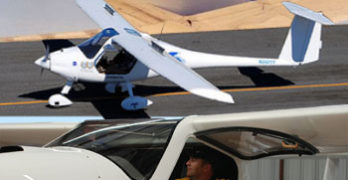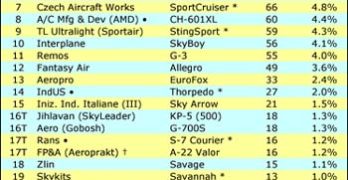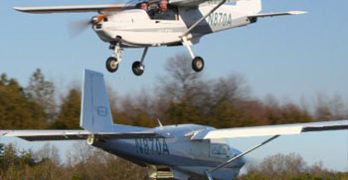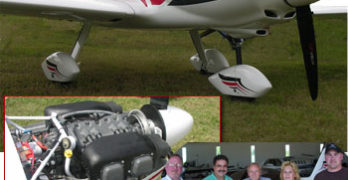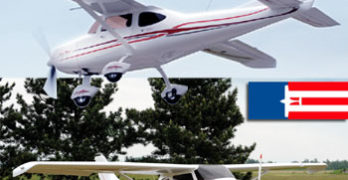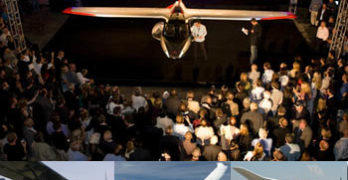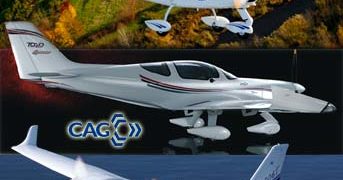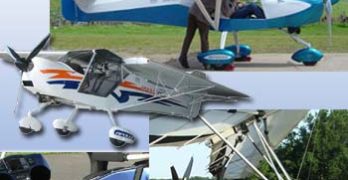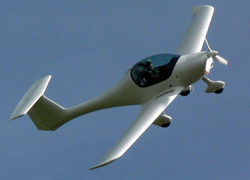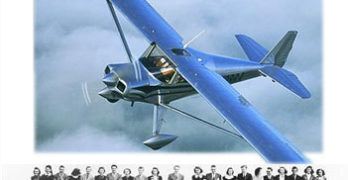Amid furious preparations for Oshkosh, CAFE Foundation, the efficiency folks, announced teams that will vie for a second year of prizes. CAFE has a $300,000 purse thanks to their partnership with NASA, which is celebrating its 50th Anniversary in 2008. *** It may not surprise you to hear that four of five teams entered will fly Light-Sport Aircraft, and at least one is sure to end in the money as one prize ($10,000) is for “Quietest LSA.” Other prizes are a maximum of $150,000 for lowest community noise; two $50,000 prizes, one for “Green,” another for safety judged by handling qualities; a $25,000 speed prize; and four $3,750 “Showcase Prizes” covering quietest cabin, best angle of climb, shortest takeoff, and best glide. Winning a couple of the larger prizes is enough money “to actually buy someone their own LSA,” said CAFE President, Brien Seeley. *** The teams competing will fly a Pipistrel Virus (last year’s big winner of $165,000!–photo); a modified Diamond DA20-A1; a Dynamic WT9; the UFM-13 Lambada, and a Flight Design CTsw.
Strong Survive 2008; LSA Market Share Adjustments
Through the first six months of 2008, Light-Sport Aircraft deliveries have reflected the same challenges afflicting the rest of general or sport aviation…and for that matter, the overall U.S. economy. In fact, LSA registrations aren’t off as badly as are GA deliveries, perhaps due to significantly better fuel economy in an LSA. These FAA registrations can be analyzed to show trends. *** In the first half of 2008, the LSA industry registered 248 aircraft, which is 22% of all registrations from April 2005 through December 2007 (1,118). Many find it interesting to observe how market leaders compare. If a supplier registered less than 22% of their fleet in 2008, they slipped in market share (even if they registered more total airplanes). If they exceeded that figure, they gained market share. In the first half of 2008 gainers included: Remos up 62%; Czech Aircraft Works 47%; FPNA 45%; Gobosh 38%; Tecnam 35%; Aeropro 32%; and AMD 28%.
Yet Another…Opus Gains SLSA Status for Super 2
Sometimes a new entry slips invisibly under the radar of organizations like EAA or myself. We both (and others) have our eyes wide open for new blips popping up on the screen. Nonetheless the folks at Opus Aircraft were stealthy enough that the Super 2 approved in February 2008 only recently appeared on our SLSA List. The Atlanta MIDO (Manufacturing Inspection District Office) approved the model first created in the UK. *** Super2 is an all-aluminum, shoulder-wing aircraft with a forward sweep to broaden visibility. Originally designed and built by ARV Aviation in England, Super 2 is now made at the Rockingham County Airport in Stoneville, North Carolina. In 1983 Brit’ designer Richard Noble set the world land speed record at Black Lake, Nevada. Opus reported, “While traveling back and forth training for his record attempt, he learned how to fly. After achieving a record, Noble returned to the United Kingdom, found flying expensive and developed a small modern light aircraft.
Falcon LS Snatches Newest SLSA Approval (#82)
Perhaps it’s the race to get ready for AirVenture 2008. Perhaps it was simply the result of months of work which finished right before the big show. Either way, welcome our newest SLSA, the Falcon LS. *** You first became aware of this airplane as the Corvus
, seen at the Aero airshow in April 2005. The gorgeous Hungarian design was created in a country lacking a bilateral agreement, government-speak meaning it could not be exported to the U.S. as a ready-to-fly LSA. So, Tomas Becse and Thomas Pizzuti — the twin Ts of T&T Aviation — are using the basic design and doing assembly in the USA to bring the shapely low wing to American customers. *** Other than Jay Kurtz’s Experimental LSA RV-9, Falcon LS is the first Light-Sport Aircraft to offer the 116-hp Lycoming O-235 (photo) as a powerplant.
TL-Ultralight Makes First Flight in New Sirius
You might say it’s Sirius when TL-3000 takes to the air for the first time. Kidding aside, the new model’s U.S. importer is seriously happy about their composite high wing making its initial flight. Czech producer TL-Ultralight makes the sleek low-wing StingSport that SportairUSA has been selling since the first SLSA lifted into American skies. In development since 2006, TL president Jiri Tlusty recently flew the carbon fiber TL-3000 for the first time. *** SportairUSA boss Bill Canino was recently in Czech Republic making arrangements to market the TL-3000 alongside the Sting S3, an advanced generation version of the TL’s successful low wing model. The Arkansas-based importer says the 46-inch wide Sirius is powered by the 100-hp Rotax 912S, has a useful load of 600 pounds, and extended range with fuel capacity of more than 30 gallons. *** As with StingSport and Sting S3, TL-3000 will come standard with high-end safety features such as a Galaxy rocket-deployed parachute system, PCAS collision avoidance, and AmSafe 4-point inertial-reel seat belts.
LSA Industry’s Fast Pace…Approaching Model #100
Despite an economic slowdown shared by all of aviation, the LSA industry is rich with entrepreneurs. Innovative new designs hit the market regularly. Consider this: In just over three years, the industry has certified an astounding 81 aircraft designs and several more are on the horizon. One hundred certified LSA might be available by 2009, in less than four years since the category was created by FAA. No one remembers anything close in FAA history. *** All Light-Sport Aircraft presently total about 1% of the U.S. piston engine fleet including all FAA registrations of all aircraft types and models. Yet three LSA years compare to 80+ Cessna years, so the new segment remains in its infancy. Consequently, the LSA industry may be acting precisely as needed — focusing on innovation and diversity as proven by the number of new models meeting ASTM standards. Big sales will follow, many experts believe.
Italy’s Tecnam Buys Producer of Spain’s Toxo LSA
Costruzioni Aeronautiche Tecnam, simply “Tecnam” to Americans, manufactures the Sierra, Bravo, Echo Super, and Eaglet SLSA. On June 10th the Italian company completed its purchase of Composite Aeronautic Group (CAG). U.S. pilots became aware of CAG’s Toxo after it won SLSA airworthiness in March 2008. *** Tecnam CEO Paolo Pascale Langer explained, “Although Tecnam is expanding capacity due to significant growth we still require more space along with enhanced access to additional technologies. CAG provided both.” *** Tecnam plans to use CAG’s Zaragoza, Spain facility to double their current production of two seat aircraft. They claim annual output of 300 light single engine aircraft per year. The company hopes to boost that figure to 600 aircraft per year by the end of 2009. *** Tecnam has been focused on their dual Rotax engine airplane, the P2006T.
Fixed Wing or Flexible…TampaBay Has Choices
Our SLSA (Special Light-Sport Aircraft) List is popular with visitors and often generates a heads-up from alert readers about some new SLSA approval that snuck under my radar. This time the heads-up made me aware of new models in two forms. *** Please welcome TampaBay AeroSport’s Apollo Fox airplane and Monsoon weight-shift trike, to which I’ve assigned SLSA numbers 80 and 81. TampaBay, aka Apollo Aircraft, has been deeply involved with Light-Sport Aircraft for some time and previously won approval for the Delta Jet trike, which sells for a reasonable $38,000. Monsoon is a sleek, highly-engineered trike available with Rotax 582 or either 912-series engine for $45,000 to $58,500. *** In early 2008, the Florida Zephyrhills airport-based TampaBay also won an airworthiness certificate for their fixed wing Apollo Fox airplane. This European two seater is a variation of the popular design originated by Avid and Kitfox.
Atec Faeta Is Number 36 to Win SLSA Approval
You may know its sibling, the Zephyr, which was present at last year’s LSA Mall at AirVenture Oshkosh. Some 90 Zephyrs are flying, mostly around Europe. But the Czech producer’s U.S. importer, Atec Aircraft, went forward with certifying the Faeta (pronounced “Fay-eht-ah”) winning their approval in early June. Atec America’s Caleb Wood reported, “It was a challenging process because the documentation we had to use was in Czech language and had to be translated to English.” In addition, he said, the documents were in a different format with a different method of organization than FAA wanted. But ultimately the data was judged sufficient and now this very shapely design is available to Americans. Caleb and his Faeta will be at EAA’s LSA Mall if he can secure exhibit space elsewhere. *** SLSA number 35 for the Apollo Delta Jet trike represents the number 4 Weight-Shift Control LSA.
Silvery LSA-8 Has a Great Tradition, Now Built New
Clyde Cessna. William Piper. Walter Beech. Al Mooney. William Boeing. You knew all that.
But do you recall the name Donald Luscombe? You probably should.
The Luscombe Aircraft Company built some 8,000 aircraft, 6,000 of them the Silvaire model alone. And they once pumped out as many as 23 per day, yes, per day! In 1948, Luscombe produced more than 2,700 aircraft in a calendar year. That’s more than twice as many as all LSA companies combined have sold in three years.
Fortunately, it isn’t just a history lesson. Thanks to John Dearden and staff at Flabob Airport in Southern California, the Luscombe was revived as the LSA-8 earning approval as a Special Light-Sport Aircraft.
Lucky me, I went flying in it with John and a pleasure it was. Great manners in a responsive, good performing, all-metal, Continental-powered LSA that is 100% Made in the USA. Selling for around $90,000 LSA-8 looks inexpensive compared to euro-denominated LSA now running to $130,000.
- « Previous Page
- 1
- …
- 37
- 38
- 39
- 40
- 41
- …
- 52
- Next Page »


